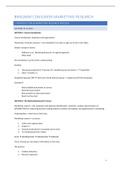Class notes
Very well structured lecture notes including practice exam - Consumer Marketing Research
- Course
- Institution
All 7 lectures are captured in this document, very well structured. Including a practice exam (questions + answers). My grade: 8.5
[Show more]



